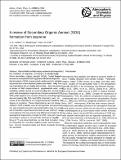| dc.contributor.author | Kroll, Jesse | |
| dc.date.accessioned | 2010-12-08T18:16:15Z | |
| dc.date.available | 2010-12-08T18:16:15Z | |
| dc.date.issued | 2009-07 | |
| dc.identifier.issn | 1680-7316 | |
| dc.identifier.uri | http://hdl.handle.net/1721.1/60228 | |
| dc.description.abstract | Recent field and laboratory evidence indicates that the oxidation of isoprene, (2-methyl-1,3-butadiene, C[subscript 5]H[subscript 8]) forms secondary organic aerosol (SOA). Global biogenic emissions of isoprene (600 Tg yr[superscript −1]) are sufficiently large that the formation of SOA in even small yields results in substantial production of atmospheric particulate matter, likely having implications for air quality and climate. Here we present a review of field measurements, experimental work, and modeling studies aimed at understanding the mechanisms, yield, and atmospheric importance of isoprene-derived SOA. SOA yields depend on a number of factors, including organic aerosol loading (M[subscript o]), NO[subscript x] level (RO[subscript 2] chemistry), and, because of the importance of multigenerational chemistry, the degree of oxidation. These dependences are not always included in SOA modules used in atmospheric transport models, and instead most yield parameterizations rely on a single set of chamber experiments (carried out over a limited range of conditions); this may lead to very different estimates of the atmospheric importance of isoprene SOA. New yield parameterizations, based on all available laboratory data (M[subscript o]=0–50 μg m[superscript −3]), are presented here, so that SOA formation may be computed as a function of M[subscript o], NO[subscript x] level, and temperature. Current research needs and future research directions are identified. | en_US |
| dc.description.sponsorship | United States. Environmental Protection Agency. Office of Research and Development | en_US |
| dc.language.iso | en_US | |
| dc.publisher | European Geosciences Union. | en_US |
| dc.relation.isversionof | http://dx.doi.org/10.5194/acp-9-4987-2009 | en_US |
| dc.rights | Creative Commons Attribution 3.0 | en_US |
| dc.rights.uri | http://creativecommons.org/licenses/by/3.0 | en_US |
| dc.source | Copernicus Publications | en_US |
| dc.title | A review of Secondary Organic Aerosol (SOA) formation from isoprene | en_US |
| dc.type | Article | en_US |
| dc.identifier.citation | Carlton, A. G., C. Wiedinmyer, and J. H. Kroll. “A review of Secondary Organic Aerosol (SOA) formation from isoprene.” Atmospheric Chemistry and Physics 9.14 (2009): 4987-5005. | en_US |
| dc.contributor.department | Massachusetts Institute of Technology. Department of Civil and Environmental Engineering | en_US |
| dc.contributor.approver | Kroll, Jesse | |
| dc.contributor.mitauthor | Kroll, Jesse | |
| dc.relation.journal | Atmospheric Chemistry and Physics | en_US |
| dc.eprint.version | Final published version | en_US |
| dc.type.uri | http://purl.org/eprint/type/JournalArticle | en_US |
| eprint.status | http://purl.org/eprint/status/PeerReviewed | en_US |
| dspace.orderedauthors | Carlton, A. G.; Wiedinmyer, C.; Kroll, J. H. | en |
| dc.identifier.orcid | https://orcid.org/0000-0002-6275-521X | |
| mit.license | PUBLISHER_CC | en_US |
| mit.metadata.status | Complete | |
